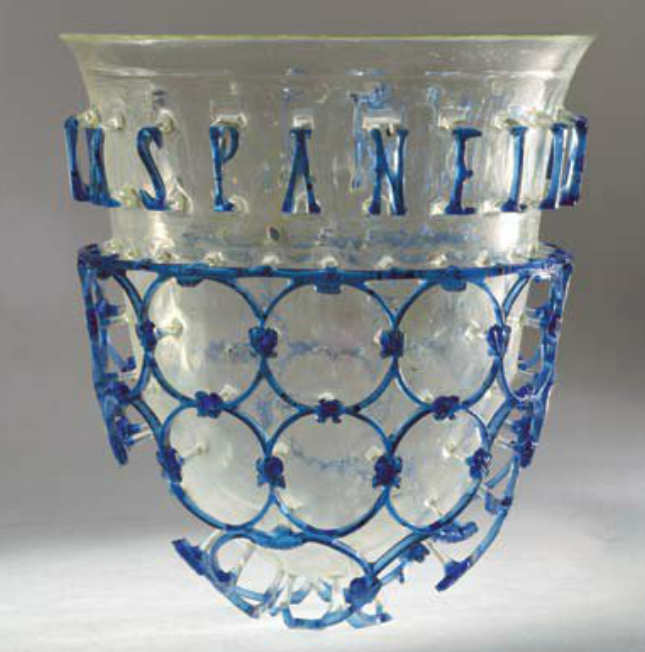|
Conchylia Cup
A conchylia cup is a Roman cup type with a conical base and a slightly everted rim, made of transparent to slightly colored glass. Its distinguishing characteristics are stylized open mouthed fish with indented fins and curving tails, often made of translucent glass and applied wavy colored threads, and affixed to the outer surface of the cup to produce its three-dimensional aspect. The most common type appears to have stylized fish swimming to the left. These vases could be entirely free-blown or their cup shape mold-blown, and the fish, or other sea creatures, free-blown onto it. The only four intact conchylia cups were found in Cologne, Trier, and Rome. Both Cologne and Trier have been suggested as manufacturing centers. Fish appliqués have been found throughout the Mediterranean, and provide no good clues for provenance. These cups were possibly used either as oil lamps, drinking vessels or for holding garum sauce. The most current thinking is that they were oil lamps, based on ... [...More Info...] [...Related Items...] OR: [Wikipedia] [Google] [Baidu] |
Ancient Rome
In modern historiography, ancient Rome refers to Roman civilisation from the founding of the city of Rome in the 8th century BC to the collapse of the Western Roman Empire in the 5th century AD. It encompasses the Roman Kingdom (753–509 BC), Roman Republic (509–27 BC) and Roman Empire (27 BC–476 AD) until the fall of the western empire. Ancient Rome began as an Italic settlement, traditionally dated to 753 BC, beside the River Tiber in the Italian Peninsula. The settlement grew into the city and polity of Rome, and came to control its neighbours through a combination of treaties and military strength. It eventually dominated the Italian Peninsula, assimilated the Greek culture of southern Italy ( Magna Grecia) and the Etruscan culture and acquired an Empire that took in much of Europe and the lands and peoples surrounding the Mediterranean Sea. It was among the largest empires in the ancient world, with an estimated 50 to 90 million inhabitants, roughly 20% of t ... [...More Info...] [...Related Items...] OR: [Wikipedia] [Google] [Baidu] |
Garum
Garum is a fermented fish sauce that was used as a condiment in the cuisines of Phoenicia, ancient Greece, Rome, Carthage and later Byzantium. Liquamen is a similar preparation, and at times they were synonymous. Although garum enjoyed its greatest popularity in the Western Mediterranean and the Roman world, it was earlier used by the Greeks. Like modern fermented fish sauce and soy sauce, garum was a rich source of umami flavoring due to the presence of glutamates. It was used along with murri in medieval Byzantine and Arab cuisine to give a savory flavor to dishes. Murri may derive from garum. Manufacture and export Pliny the Elder and Isidore of Seville derive the Latin word from the Greek (), a food named by Aristophanes, Sophocles, and Aeschylus. Garos may have been a type of fish, or a fish sauce similar to garum. Pliny stated that garum was made from fish intestines, with salt, creating a liquor, the garum, and the fish paste named (h)allec or allex (similar to , ... [...More Info...] [...Related Items...] OR: [Wikipedia] [Google] [Baidu] |
Römisch-Germanisches Museum
The Roman-Germanic Museum (RGM, in German: ''Römisch-Germanisches Museum'') is an archaeological museum in Cologne, Germany. It has a large collection of Roman artifacts from the Roman settlement of ''Colonia Claudia Ara Agrippinensium'', on which modern Cologne is built. The museum protects the original site of a Roman town villa, from which a large Dionysus mosaic remains in its original place in the basement, and the related Roman Road just outside. In this respect the museum is an archaeological site. The museum also has the task of preserving the Roman cultural heritage of Cologne, and therefore houses an extensive collection of Roman glass from funerals and burials and also exercises archaeological supervision over the construction of the Cologne underground. Most of the museum's collection was housed at the Wallraf-Richartz Museum in Cologne until 1946. In the front of the museum the former northern town gate of Cologne with the inscription CCAA (for Colonia Claudia ... [...More Info...] [...Related Items...] OR: [Wikipedia] [Google] [Baidu] |
Cage Cup
A cage cup, also ''vas diatretum'', plural ''diatreta'', or "reticulated cup" is a type of luxury late Roman glass vessel, found from roughly the 4th century, and "the pinnacle of Roman achievements in glass-making". ''Diatreta'' consist of an inner beaker and an outer cage or shell of decoration that stands out from the body of the cup, to which it is attached by short stems or shanks. About fifty cups or, more often, fragments have survived, and there are only a few in near-complete condition. Most have a cage with circular geometrical patterns, often with an "inscription", or phrase in letters above the reticulated area as well. Some have a flange, or zone of projecting open-cut moulding, above the lower patterns and below the lettering (only illustrated here by the Cologne cup in the gallery). Even rarer are examples with scenes with figures, of which the Lycurgus Cup in the British Museum is the only complete example to survive, though there are other fragments. In this ... [...More Info...] [...Related Items...] OR: [Wikipedia] [Google] [Baidu] |


